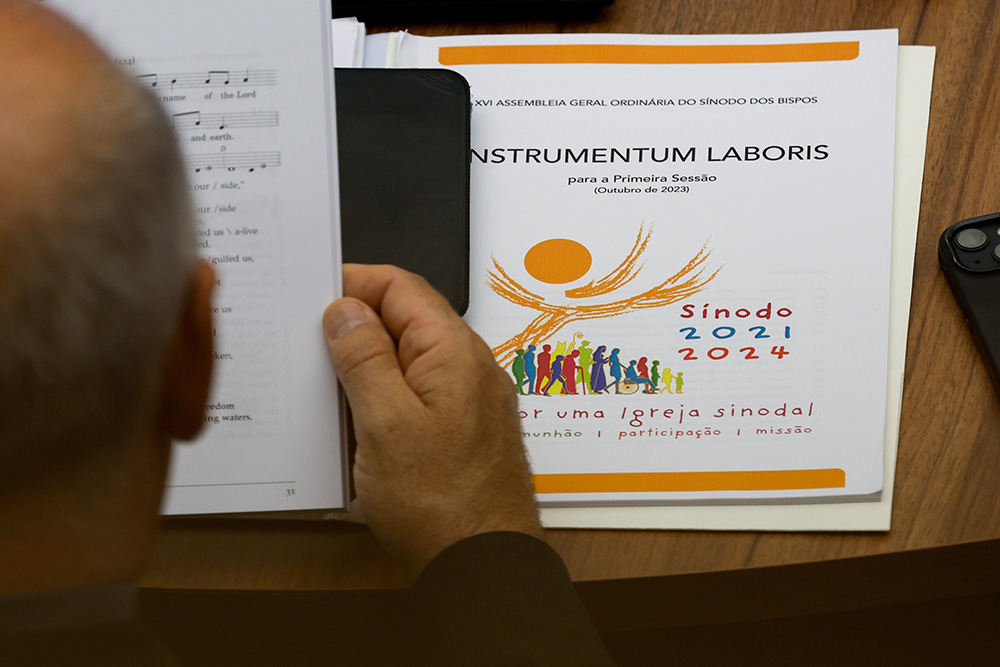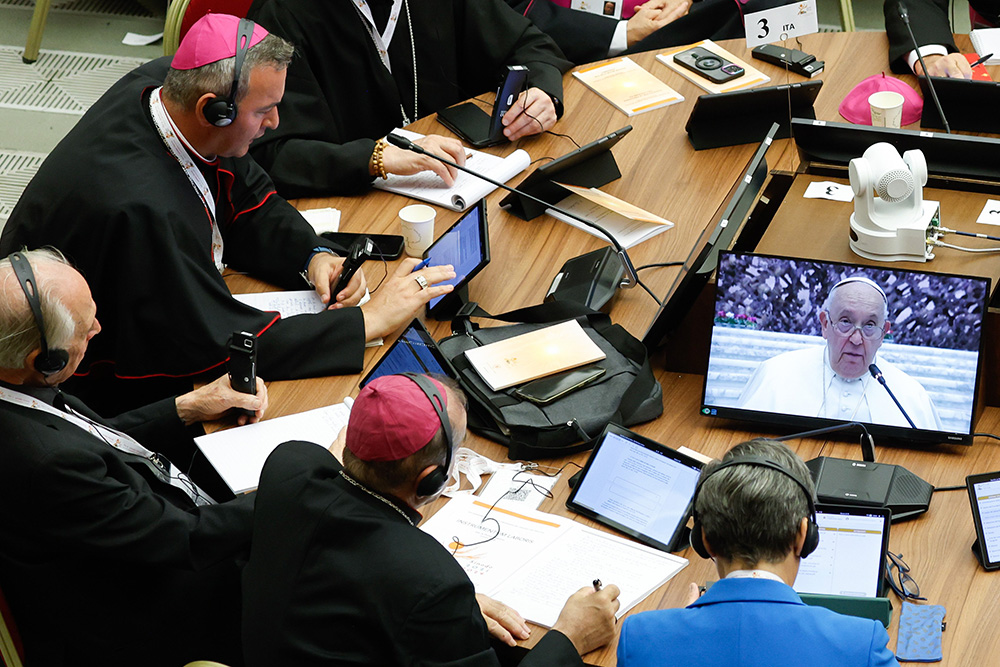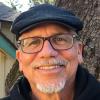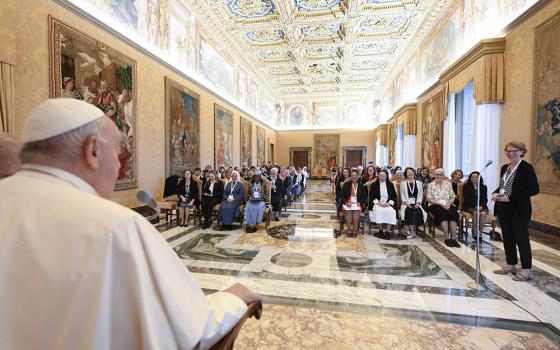
A participant prays in the Vatican's Paul VI Audience Hall at the beginning of a working session of the assembly of the Synod of Bishops Oct. 10, 2023. (CNS/Lola Gomez)
I love the Catholic Church, and it also drives me crazy. The contradictions, shortcomings and self-inflicted wounds often boggle the mind. The synodal process and the October 2023 synod assembly in Rome highlights these disparate feelings. To begin with, it is astonishing that so many Catholics, from lay people to cardinals, are publicly condemning the process. It is one thing to choose not to participate, it is quite another to rant about heresy and folly.
What I find most intriguing about the opposition is that Pope Francis has repeatedly said that listening with the heart, going to the peripheries, hearing from those who are or have been wounded — that is how we collectively discern where the Holy Spirit is calling us. Jesus told Nicodemus the Spirit is like the wind, which "blows where it chooses, and you hear the sound of it, but you do not know where it comes from or where it goes" (John 3:8). Given this clear description of God's ways as beyond our understanding, (Isaiah 55:8-9), I am stunned that so many fallible humans see themselves as guardians, protectors and gatekeepers of a supposed divine and unchanging truth.
Now that the first session of the synod in Rome is complete, we have time to read and absorb the summary document, known as a synthesis report, of the four week assembly. After hearing both the praise and critique of the report, I spent some time with the document.
Advertisement
One impression I have is the same one I have after reading many Catholic documents. If we could but live the lofty language, our church would be a light and model of peace and unity to humanity. Lumen gentium, Evangelii Nuntiandi, Pacem in Terris, Populorum Progressio, Laudato Si', Evangelii Gaudium, Fratelli tutti and many other such documents demonstrate the beauty of life in Christ and service to the world.
After reading the synthesis report, you cannot help but have a deep respect for those who created, participated in and attended the synod. Many of them have referred to enhancing their own spiritual practices prior to the synod, and have spoken of the retreats, prayer vigils and liturgies they attended.
Further, the delegates listened, talked and prayed with each other for an entire month. Over 400 devoted Catholics, each with their own story, background, vocation, culture and nation, worked to listen to each other and to the Holy Spirit. They then reviewed each section and proposal of the summary document and voted on the sections that were eventually approved for inclusion.
The report is divided into three parts: "The Face of the Synodal Church," "All Disciples, All Missionaries," and "Weaving Bonds, Building Communities." There are 81 distinct proposals to implement in preparation for and beyond the 2024 October synod. That strikes me as a lot of follow up actions, but then again there are 1.3 billion Catholics in the world; certainly, enough hands to work assuming a willing heart.
There are some proposals that I find the most compelling and urgent.

Participants watch Pope Francis on a video screen as they work on their tablets with synod documents during the first session of the assembly of the Synod of Bishops in the Paul VI Audience Hall at the Vatican Oct. 4, 2023. (CNS/Lola Gomez)
Part I, Section 2 asks that churches "experiment with" the "conversation in the Spirit" style of discussion and train individuals to facilitate that process. Conversations in the Spirit include listening, silence and prayer — without judgment or a formulated retort from the listener. There is also a period of reflecting back what was heard and collective discernment. Imagine this as an ongoing vocation and ministry in our local parishes.
Part I, Section 4 urges churches to both teach and act upon the rich resources of Catholic social teaching. I was a Catholic for 10 years before I knew of this treasure house — and it never ceases to amaze.
Part I, Section 5 recommends we dialogue and discern on the question of racial justice; and, to identify systems of racial injustice in the church and create processes for healing and reconciliation. As an African American Catholic, I am dismayed at the history and current practice of racial injustice in the church. This would be a most refreshing change.
The U.S. Conference of Catholic Bishops 2021-2024 Strategic Plan includes an initiative on "Life and Dignity of the Human Person: Serve the common good as a leaven in a free society." Under this theme is a goal to host a national Catholic anti-racism gathering. Imagine that bold initiative as the beginning of the American Catholic Church's work to repent of and renew its approach to racial justice.
Part II, Section 8 includes recommendations to further involve young people and enhance the role of lector to include preaching. I attended a parish in Seattle that included lay homilists often, and the church was much enriched by this ministry.
Part II, Section 9 includes several recommendations on women in decision-making, potentially in the diaconate, and other areas. Having been confirmed in a church with a woman pastoral life director, I can witness to the advantages of female parish leadership. When I completed Seattle University's School of Theology and Ministry Master of Arts in Pastoral Studies program, many of my classmates were talented Catholic women seeking a place to serve in a church that restricted their gifts.
Part II, Section 12 includes a proposal for structures and processes for reviewing a diocesan bishop's performance. Given the importance of the role in the life of the dioceses and the parishes, this is a critical issue.
Reform, growth, revival, improvement are all necessary components of our lives as Catholics.
Part III, Section 14 includes recommendations on the priority need for ongoing joint formation for "the entire People of God" (laity, consecrated and ordained ministry) in light of synodality. There is also a recommendation to enhance formation of ordained ministers given their important role in promoting a synodal church at all levels.
Part III, Section 15 addresses sexual identity and sexuality, and suggests shared discernment with experts in these fields, and with the "people directly affected by the matters under consideration." Currently, LGBT persons are met with an array of condemning terms, exclusive policies and lack of understanding by official church teachings. Sections 2357-59 of the Catechism of the Catholic Church refer to "homosexual acts" as "intrinsically disordered." This incredible finding persists despite science, testimony of LGBT persons, and frankly, what was obvious to me when I was 10-years-old: that the boys and girls I grew up with who were gay were not disordered, but that is just who they were.
These are just a few of the proposals which in my judgment could dramatically elevate our witness as Christ's body on earth. Reform, growth, revival, improvement are all necessary components of our lives as Catholics. Either we are perfect with no need for enhancement, or we collectively open ourselves to listen to each other, and to the Spirit — the Spirit which seeks to take us places we have yet to go.
Finally, the pope urges that we not observe the synodal meetings from a distance, but that each of us, in our parish, vocation, informal gatherings and other venues, be a people that listens with the heart and goes to uncomfortable places to hear and respond to "the joys and hopes, the griefs and anxieties of the followers of Christ" (Gaudium et spes, 1).







